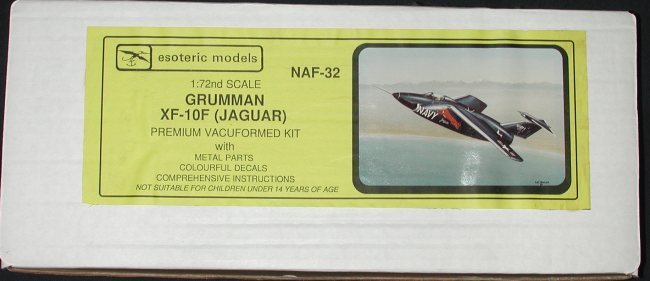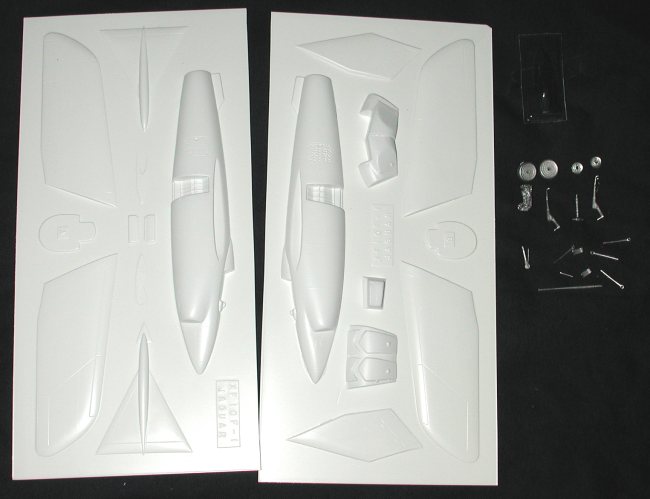
| KIT: | Esoteric 1/72 XF10F-1 Jaguar |
| KIT # | NAF 32 |
| PRICE: | @$25.00 |
| DECALS: | One aircraft |
| REVIEW & | |
| NOTES: | Vacuform with white metal |

| HISTORY |
The XF10F-1 is the world's first variable-sweep fighter, flyingfor the first time in May of 1952. However, like so many other aircraft of thetime, it was doomed to failure. First by the anemic engine that was chosen, theWestinghouse J-40, an engine that never lived up to anywhere near its promisedcapabilities. The aircraft was also beset with teething troubles, fromimproperly operating slats to rudder buffet to failing fuel control units tomajor longitudinal control problems.
The tail section was redesigned a number of times without anyreal success. When the horizontal stabilizer was finally replaced with one froman F9F, it looked like the stability problems were over. However, the Navy wasfed up with the seemingly endless problems associated with the Westinghouseengine and eventually cancelled the program in April of 1953. Throughout thistime, there was never any problems at all with the swing-wing or its mechanism.What was learned from this stood Grumman in good stead when it came todeveloping the Tomcat.
The XF10F (called the Jaguar) never flew for more than 67minutes, never went faster than Mach.86 in level flight, never went higher than31,500 feet, and never met any of the criteria of the program. Much ofthis can be laid at the feet of the pathetic J-40 turbojet, which never camenear meeting specifications. Only the one prototype was completed, though thesecond was 90% finished when the program came to an abrupt halt. Both prototypeswere expended in barrier testing and no part of this interesting aircraft hassurvived.
| THE KIT |

Esoteric was a company that produced a number of veryinteresting aircraft, all of them USN related. They were basically multimediakits and included resin and/or metal parts as well as decals. The major part ofthe kits were in vacuformed plastic. This one is no different. There are twosheets of vac plastic, a bag of metal bits and a decal sheet all packed into avery sturdy box.
The vacuformed parts are well done with engravedpanel lines and minimal 'pips' on the surface. There is one vacuformed canopy.White metal parts are included for the landing gear and seat. You will have tomake a few of the bits from the scrap card, but nothing too difficult.
Overall,it looks like a very nice kit. I'd recommend some vac building experience beforetackling this one. Grumman Aircraft since 1929 by Rene J Francillon, 1989, Naval InstitutePress Review kit courtesy of me and my wallet! If you would like your product reviewed fairly and quickly by asite that averages over 2,000 visits a day, please contactme or see other details in the